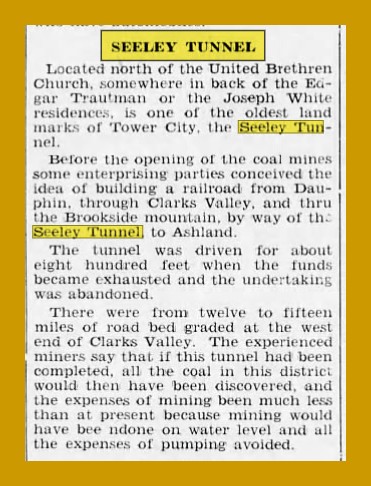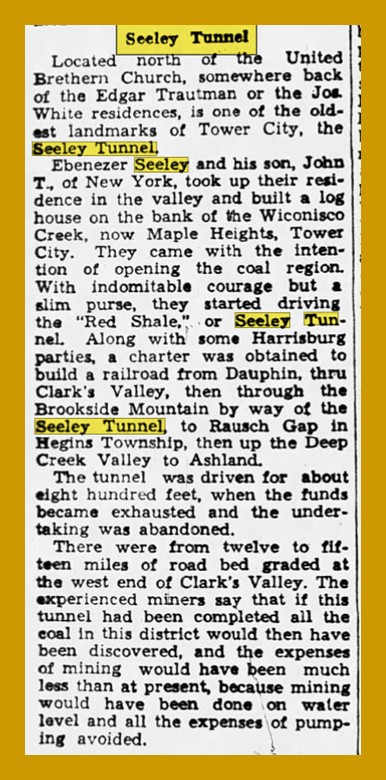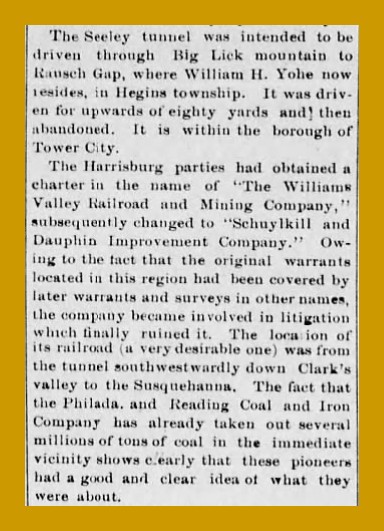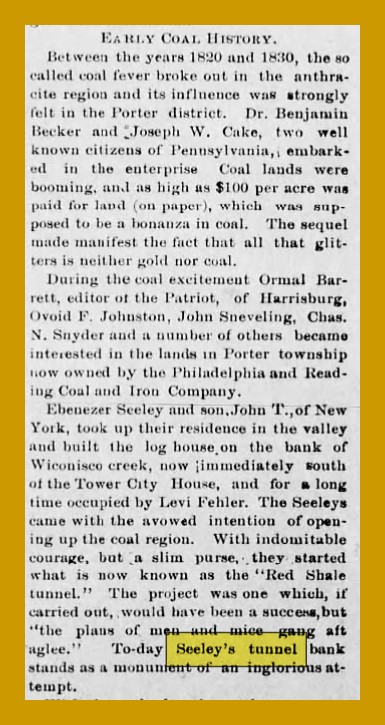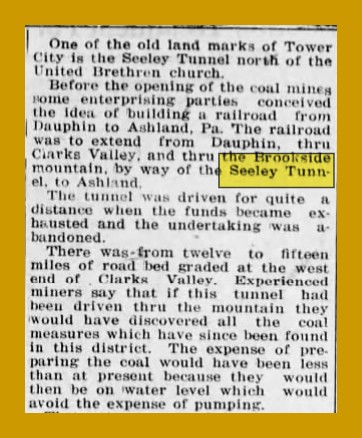The Seeley Tunnel was a project undertaken in 1843. The intent was build a railroad from Dauphin Borough through Clarks Valley in Dauphin County, to Ashland in Schuylkill County. However, a tunnel was required to go under the mountain from Tower City to a point in Hegins Township south of Valley View. The tunnel was abandoned after the promoters were unable to receive funding needed to complete it.
Additional research needs to be done to give a more complete story of the project and why it failed – and to determine if it succeeded, would the area have have been opened more quickly to coal development.
Some newspaper articles are presented here to give a little of the background information of the Seeley Tunnel.
___________________________________________
From a “Letter to the Editor” of the West Schuylkill Herald, June 16, 1933:
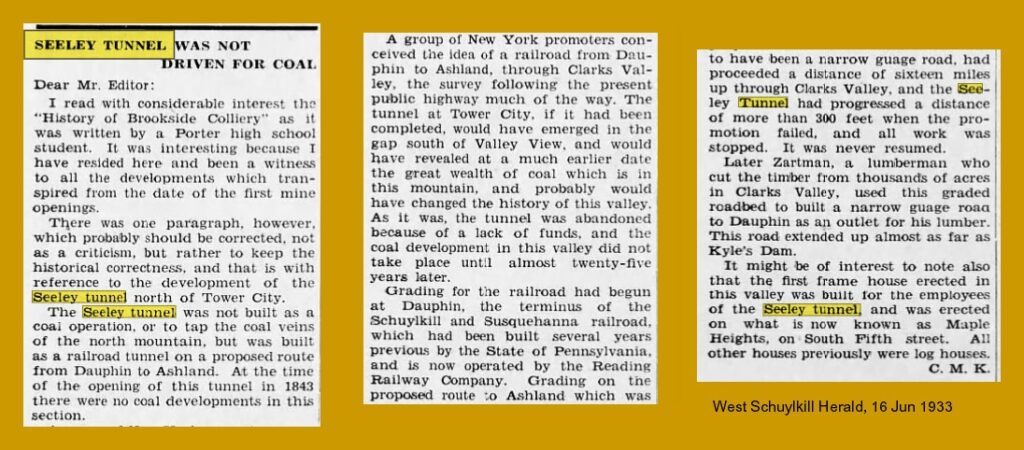
SEELEY TUNNEL WAS NOT DRIVEN FOR COAL
Dear Mr. Editor:
I read with considerable interest the “History of Brookside Colliery” as it was written by a Porter [Township] High School student. It was interesting because I have resided here and been a witness to all the developments which transpired from the date of the first mine openings.
There was one paragraph, however, which probably should be corrected, not as a criticism, but rather to keep the historical correctness, and that is with reference to the development of the Seeley Tunnel north of Tower City.
The Seeley Tunnel was not built as a coal operation, or to tap the coal veins of the north mountain, but was built as a railroad tunnel on a proposed route from Dauphin to Ashland. At the time of the opening of this tunnel in 1843 there were no coal developments in this section.
A group of New York promoters conceived the idea of a railroad from dauphin to Ashland, through Clarks Valley, the survey following the present public highway much of the way. The tunnel at Tower City, if it had been completed, would have emerged in the gap south of Valley View, and would have revealed at a much earlier date the great wealth of coal which is in this mountain, and probably would have changed the history of this valley. As it was, the tunnel was abandoned because of a lack of funds, and the coal development in this valley did not take place until almost twenty-five years later.
Grading for the railroad had begun at Dauphin, the terminus of the Schuylkill and Susquehanna Railroad, which had been built several years previous by the State of Pennsylvania, and is now operated by the Reading Railway Company. Grading on the proposed route to Ashland which was to have been a narrow gauge road, had proceeded a distance of sixteen miles up through Clarks Valley, and the Seeley Tunnel had progressed a distance of more than 300 feet when the promotion failed, and all work was stopped. It was never resumed.
Later Zartman, a lumberman who cut the timber from thousands of acres in Clarks Valley, used this graded roadbed to build a narrow gauge road to dauphin as an outlet for his lumber. This road extended up almost as far as Kyle’s Dam.
It might be of interest to note also that the first frame house erected in this valley was built for the employees of the Seeley Tunnel, and was erected on what is now known as Maple Heights, on South Fifth Street. All other houses were log houses.
C. M. K.
____________________________________________________
From Munsell’s History of Schuylkill County, published in 1881:
The Seeley Tunnel was intended to be driven through Big Lick Mountain to Rausch Gap, where William H. Yohe now resides, in Hegins Township. It was driven for upwards of eighty yards and then abandoned. It is within the bounds of the present village of Tower City.
The Harrisburg parties had obtained a charter in the name of "The Williams Valley Railroad and Mining Company," subsequently changed to "Schuylkill and Dauphin Improvement Company." Owing to the fact that the original warrants located in this region had been covered by later warrants and surveys in other names, the company became involved in litigation which finally ruined it. The location of its railroad (a very desirable one) was from the tunnel southwestwardly down Clark's Valley to the Susquehanna. The fact that the Philadelphia and Reading Coal and Iron Company has already taken out several millions of tons of coal in the immediate vicinity shows clearly that these pioneers had a good and clear idea of what they were about.
_______________________________________________
From the West Schuylkill Press, “History of Tower City,” by Junior Class of Porter Township High School, February 23, 1934:
SEELEY TUNNEL
Located north of the United Brethren Church, somewhere in back of the Edgar Trautman or in the Joseph White residences, is one of the oldest landmarks of Tower City, the Seeley Tunnel.
Before the opening of the coal mines some enterprising parties conceived the idea of building a railroad from Dauphin, through Clarks Valley and thru the Brookside Mountain, by way of the Seeley Tunnel to Ashland.
The tunnel was driven for about eight hundred feet when the funds became exhausted and the undertaking was abandoned.
There were from twelve to fifteen miles of road bed graded at the west end of Clarks Valley. The experienced miners say that if this tunnel had been completed, all the coal in this district would then have been discovered, and the expenses of mining been much less than at present because mining would have been done on water level and all the expenses of pumping avoided.
___________________________________________
From the Pottsville Republican, December 21, 1934, a reprint of Joseph H. Zerbey‘s article from page 1157 of his Pottsville History:
SEELEY TUNNEL
Located north of the United Brethren Church, somewhere back of the Edgar Trautman or the Joseph White residences, is one of the oldest landmarks of Tower City, the Seeley Tunnel.
Ebenezer Seeley and his son John Seeley, of New York, took up their residence in the alley and built a log house on the bank of the Wiconisco Creek, now Maple Heights, Tower City. They came with the intention of opening the coal region. With indomitable courage but a slim purse, they started driving the “Red Shale,” or Seeley Tunnel. Along with some Harrisburg parties, a charter was obtained to build a railroad from Dauphin, thru Clarks Valley, then through the Brookside Mountain by way of the Seeley Tunnel, to Rausch Gap in Hegins Township, then up the Deep Creek Valley to Ashland.
The tunnel was driven for about eight hundred feet, when the funds became exhausted and the undertaking was abandoned.
There were from twelve to fifteen miles of road bed graded at the west end of Clarks Valley. The experienced miners say that if this tunnel had been completed, all the coal in this district would then have been discovered, and the expenses of mining would have been much less than at present, because mining would have been done on water level and all the expenses of pumping avoided.
_____________________________________________
From the West Schuylkill Herald, “Early History of Porter Township,” March 17, 1904:
The Seeley Tunnel was intended to be driven through Big Lick Mountain to Rausch Gap, where William H. Yohe now resides, in Hegins Township. It was driven for upwards of eighty yards and then abandoned. It is within the borough of Tower City.
The Harrisburg parties had obtained a charter in the name of “The Williams Valley railroad and Mining Company,” subsequently changed to “Schuylkill and Dauphin Improvement Company.” Owing to the fact that the original warrants located in this region had been covered by later warrants and surveys in other names, the company became involved in litigation which finally ruined it. The location of its railroad (a very desirable one) was from the tunnel southwestwardly down Clark’s Valley to the Susquehanna. The fact that the Philadelphia and Reading Coal and Iron Company has already taken out several millions of tons of coal in the immediate vicinity shows clearly that these pioneers had a good and clear idea of what they were about.
________________________________________________
From the West Schuylkill Herald, March 10, 1904:
EARLY COAL HISTORY
Between the years 1820 and 1830, the so-called coal fever broke out in the anthracite region and its influence was strongly felt in the Porter district. Dr. Benjamin Becker and Joseph W. Cake, two well-known citizens of Pennsylvania, embarked in the enterprise. Coal lands were booming, and as high as $100 per acre was paid for land (on paper), which was supposed to be a bonanza in coal. The sequel made manifest the fact that all that glitters is neither gold nor coal.
During the coal excitement, Ormal Barrett, editor of the Patriot, of Harrisburg, Ovoid F. Johnson, John Sneveling, Charles N. Snyder and a number of others became interested in the lands in Porter Township now owned by the Philadelphia and Reading Coal and Iron Company.
Ebenezer Seeley and son John T. Seeley, of New York, took up their residence in the valley and built the log house, on the bank of Wiconisco Creek, now immediately south of the Tower City House, and for a long time occupied by Levi Fehler. The Seeleys came with the avowed intention of opening up the coal region. With indomitable courage, but a slim purse, they started what is now known as the “Red Shale Tunnel.” The project was one which, if carried out, would have been a success, but “the plans of men and mice gang aft aglee.” Today, Seeley’s Tunnel bank stands as a monument of an inglorious attempt.
____________________________________________________
From the West Schuylkill Herald, June 29, 1921:
One of the old landmarks of Tower City is the Seeley Tunnel north of the United Brethren Church.
Before the opening of the coal mines some enterprising parties conceived the idea of building a railroad from Dauphin to Ashland, Pennsylvania. The railroad was to extend from Dauphin, thru Clarks Valley, and thru the Brookside Mountain by way of the Seeley Tunnel, to Ashland.
The tunnel was driven for quite a distance when the funds became exhausted and the undertaking was abandoned.
There was from twelve to fifteen miles of road bed graded at the west end of Clarks Valley. Experienced miners say say that if this tunnel had been driven thru the mountain they would have discovered all the coal measures which have since been found in this district. The expense of preparing the coal would have been less than at present because they would then be on water level which would avoid the expense of pumping.
_______________________________________________
Articles from Newspapers.com.
Corrections and additional information should be added as comments to this post.
